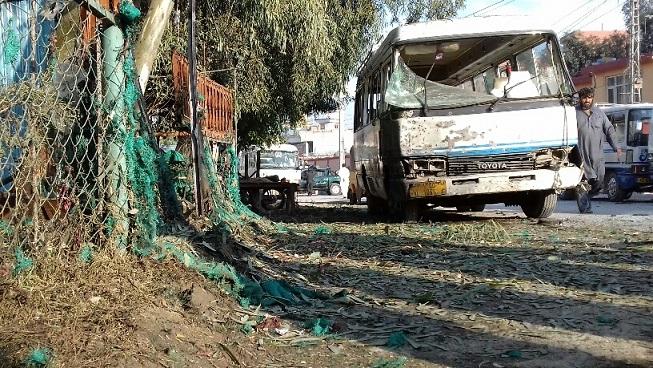KABUL (Pajhwok): Casualties from the conflict in Afghanistan declined by 42 percent in November when 1,476 people were killed and wounded in 147 attacks, Pajhwok Afghan News has learnt.
The attacks fell by 13 percent during the month compared to October, according to Pajhwok Afghan News reports based on different sources. In November, attacks happened in 27 provinces.
Attacks:
The violent incidents taking place in November included 67 face-to-face clashes, 26 targeted killings, 19 different types of blasts and nine suicide attacks.
Pajhwok reports show of every 25 people, 15 suffered casualties in direct fighting, 50 in airstrikes, three in bomb blasts, two in suicide explosions and one in targeted attacks.
Nangarhar witnessed 27 attacks – the most — in November followed by Ghazni province where 16 attacks happened. There were 13 attacks in Faryab, 12 in Farah and the remaining in 23 provinces of the country.
Like October, in November too Nuristan and Daikundi provinces evaded violence. There was no report about casualties from Badghis, Bamyan and Takhar provinces in October and no report of casualties from Baghlan, Ghor, Panjsher and Samangan provinces in November.
Last month, more attacks took place in Nangarhar compared to other provinces.
Military affairs expert Gen. Abdul Wahid Taqat said Nangarhar was located on the border with Pakistan and therefore more attacks happened there. In addition, Nangarhar’s geographical location suited militancy and militants were more comfortable there, he added.
He said Taliban and Daesh militants were more active in Nangarhar than other provinces and government forces also targeted the rebels in operations, thus the province witnessed more violence.
Casualties:
According to reports, 836 people have been killed and 640 injured in 147 attacks last month.
The dead and injured included armed militants, security forces and civilians. However, Pajhwok could not publish exact casualty figures as different sources provided different accounts.
Nearly half of the total casualties in November happened in Kandahar, Nangarhar, Ghazni, Farah and Uruzgan provinces and the remaining half took place in other 22 provinces.
The deadliest day was November 14 when 183 people were killed and injured in Kandahar’s Maiwand district.
According to Kandahar police, 67 people were killed and 50 others injured on both sides when militants stormed Afghan security forces check-points.
After Kandahar, 173 people suffered casualties in Nangarhar, where most of the attacks occurred in November.
In October, most of the casualties occurred in Paktia and Nangarhar provinces where 297 and 268 people suffered casualties respectively.
According to Pajhwok tally, November casualties decreased by 12 percent compared to the same month of last year.
Pajhwok’s monthly reports about casualties in Afghanistan show more than 23,000 people suffered casualties this year. Of them 13,550 individuals were killed and the rest wounded.
Military affairs expert retired Gen. Abdul Wahid Taqat said casualties in clashes depended on the war’s nature; as if attacks were frontal or coordinated, then casualties would also be high.
According to him, the Pakistani and other foreign intelligence active in Afghanistan were behind “the reduction and increase in attacks.”
Taqat alleged attacks usually decreased in winter when anti-government insurgents returned to their safe havens across the border for further military training and supplies.
Last year too, casualties dropped in winter compared to summer months. In winter last year, about 1,500 individuals suffered casualties averagely on a monthly basis. But in summer that year nearly 2,500 people suffered casualties per month.
Defence Ministry spokesman Maj.Gen. Dawlat Wazeri said 60 percent declined had been noticed in the movements of militant groups recently.
Inflicting heavy casualties to the rebels in last spring and summer, increase in airstrikes on the insurgents, International pressure on Pakistan and to the some extent the increasing cold weather were the main reasons behind the decline in rebels activities.
The believed Afghan forces operations would continue in the winter but there will be more decline in rebels’ attacks.
The spokesman added the enemy suffered more casualties in spring and summer therefore it was unable to fight security forces in winter.
“We are happy about winter when fighting subsides”
This is the voice of Afghan war victims who have been longing for peace.
A resident of Koti Ashro area in Maidan Shahr, the capital of central Maidan Wardak province, Shamsul Haq, said his 31-year-old cousin, Mohammad Khalid, was killed after being hit by a stry bullet a few days ago while he was working in his garden.
He said Khalid left behind her wife and two daughters.
He said Afghans were thirsty for peace and asked the warring sides to declare ceasefire and resolve their differences through talks in order to save more innocent lives from being lost.
Shamsul Haq said this year’s fighting in Wardak and other provinces had resulted in casualties to civilians as well as the warring sides.
“We hate the name of firing. We are happy about winter because fighting reduces in this season.”
Meanwhile, a resident of Kandahar City, the capital of southern Kandahar province, Allauddin, whose farmer brother got wounded in a landmine explosion, said Afghans were fed-up with wars and they wanted peace.
He also expressed his happiness over the arrival of winter because fighting and casualties usually decrease due to harsh cold weather.
nh/sns/ma
Views: 13
